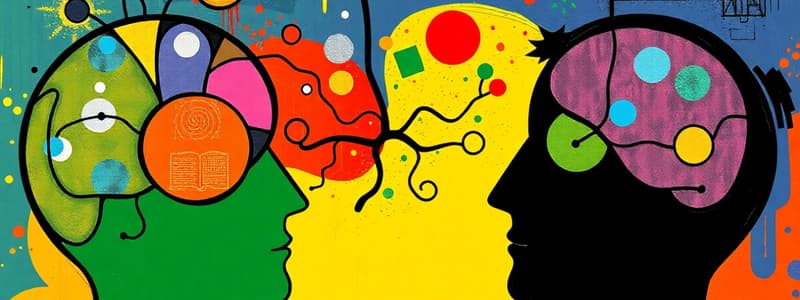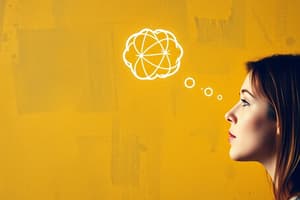Podcast
Questions and Answers
¿Cuál es uno de los principios fundamentales del pensamiento lateral?
¿Cuál es uno de los principios fundamentales del pensamiento lateral?
¿Qué técnica se utiliza para la lluvia de ideas en el contexto del pensamiento lateral?
¿Qué técnica se utiliza para la lluvia de ideas en el contexto del pensamiento lateral?
¿Cuál de los siguientes no es un proceso de la teoría de los 4 procesos del pensamiento según Jorge Pinedo Rivera?
¿Cuál de los siguientes no es un proceso de la teoría de los 4 procesos del pensamiento según Jorge Pinedo Rivera?
¿Cómo se pueden clasificar las ideas generadas en el pensamiento lateral?
¿Cómo se pueden clasificar las ideas generadas en el pensamiento lateral?
Signup and view all the answers
En el contexto del pensamiento lateral, ¿qué implica el 'tratamiento de las ideas'?
En el contexto del pensamiento lateral, ¿qué implica el 'tratamiento de las ideas'?
Signup and view all the answers
Study Notes
Instrumentos y Técnicas del Pensamiento Lateral
- Lateral thinking, unlike vertical thinking, seeks novel solutions by exploring diverse perspectives and reframing problems.
- Reframing: Viewing a problem from different angles, questioning assumptions, and considering alternative interpretations.
- Challenging Assumptions: Identifying and questioning underlying assumptions, preconceptions, and limitations that hinder creative solutions.
- Analogies and Metaphors: Utilizing analogies, metaphors, and comparisons to find insights and new possibilities.
- Random Input: Employing unexpected connections and unconventional associations to spark new ideas (e.g., brainstorming with unrelated objects).
- Forced Relationships: Intentionally connecting seemingly unrelated concepts to produce new ideas and solutions.
- Questioning Techniques: Using open-ended, probing questions to delve into the core of a problem and generate more options.
- Role Playing: Adopting different perspectives, or even those of opposing parties, to understand the problem from varied viewpoints.
- Suspension of Judgement: Putting aside immediate judgments to prevent limiting creative exploration.
Tratamiento de las Ideas
- Idea Generation: Creating a large pool of possible ideas, regardless of their feasibility initially. Quantity over quality in the process.
- Idea Evaluation: Assessing the generated ideas based on pre-defined criteria and selecting those promising further development.
- Elaboration and Development: Expanding on promising ideas, refining them, and turning them into comprehensive solutions.
- Critical Thinking: Evaluating ideas based on logic, evidence, and potential impact. Not just accepting ideas but scrutinizing them.
- Idea Rejection: Deciding which ideas are not viable or beneficial for the problem at hand.
- Refinement: Iterative improvement of promising ideas, adding detail, strength, and clarity.
Teoría de los 4 Procesos del Pensamiento (Jorge Pinedo Rivera)
- This theory outlines four key processes in the thought process, emphasizing the importance of flexible and open-minded mental models for innovative problem-solving.
- Procesamiento de Datos: Focuses on gathering, organizing, interpreting information related to the problem. This is akin to information gathering and critical analysis often needing to be done with a broad range of material.
- Conceptualización: The process of associating and connecting ideas, forming concepts, and identifying patterns. This stage emphasizes bringing together fragments of information and looking for linkages.
- Evaluación: Critically assessing the potential solutions, considering feasibility, risks, and other relevant factors. This is where the "practical" aspects of the solution are considered.
- Decision: Choosing a suitable solution, aligning with broader objectives and criteria. This often involves weighing multiple and potentially competing alternatives.
Studying That Suits You
Use AI to generate personalized quizzes and flashcards to suit your learning preferences.
Description
Explora las herramientas y técnicas del pensamiento lateral que fomentan la creatividad y la resolución de problemas. Este cuestionario abarca conceptos como el cambio de perspectiva, la identificación de suposiciones y el uso de analogías para encontrar soluciones novedosas. ¡Ponte a prueba y aprende cómo el pensamiento lateral puede transformar tus ideas!




